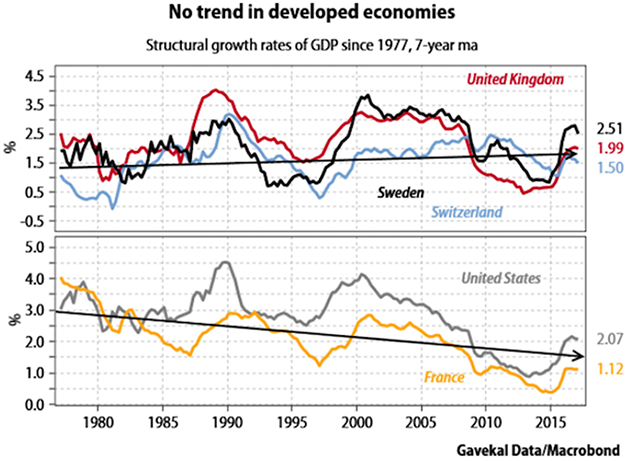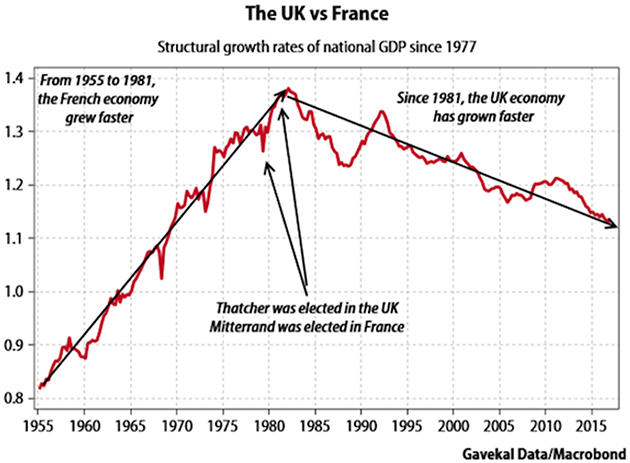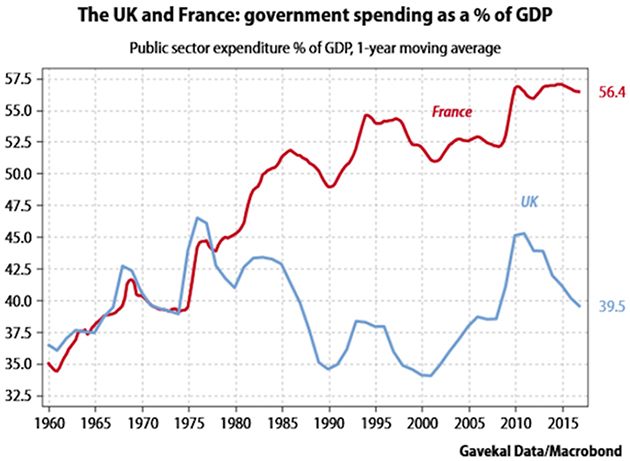Säkulare Stagnation – à la Eiszeit – wirklich das Problem?
Ich halte bekanntlich viel von der Annahme geringerer Wachstumsraten aufgrund von Demografie, Produktivität und Überschuldung. Die These wird von anderen unter dem Stichwort “säkulare Stagnation” propagiert, die jedoch die Hauptursache in den Ersparnisüberschüssen sehen, vor allem von China und Deutschland.
Doch stimmt die These überhaupt? Charles Gave vertritt eine andere These:
- “So We Are In Secular Stagnation really? I would advise readers to consider the chart below. (…) both the US and France have seen a slump in their “structural” GDP growth rate, as shown by the seven year moving average. (…) Yet, (…) it is clear that this growth slump has hardly been generalized. Since the late 1970s, Sweden, the UK and Switzerland have seen their growth rates rise structurally, and the same pattern can be found with Canada, Germany and Australia.” – bto: was natürlich ein berechtigter Einwand ist.

Quelle: Gavekal
- “So why have certain economies tumbled into relative decline, while others have not? A useful approach may be to compare France and the UK, which are similar in size, population and demographic profile. (…) The obvious point is that between 1955 and 1981, France’s economy massively outperformed the UK’s. Since 1981, the reverse has been true.” – bto: Das spricht dafür, dass es eine wirkungsvolle Politik gegeben hat.

Quelle: Gavekal
- “Under Margaret Thatcher, the UK forged a new path by lessening the role of civil servants in managing economic activity. In France, François Mitterrand expressly aimed to expand the scope of government.” – bto: Man sollte auch anmerken, dass es in UK eine sehr einseitige Orientierung auf den Finanzsektor gegeben hat mit einer Konzentration auf London. Ich würde das skeptischer beurteilen auf mittlere Sicht.

Quelle: Gavekal
- “The next task is to explore potential cause-and-effect linkages between public spending and the divergence in the structural growth rates of France and the UK. As such, consider the chart below which reconciles growth and government spending in the two economies.” – bto: Ein hoher Staatsanteil korreliert mit geringeren Wachstumsraten. Das zeigen übrigens auch andere Studien, u. a. von der OECD.

Quelle: Gavekal
- “(…) beyond a certain threshold (that varies by country) more state spending causes the structural growth rate to fall.” – bto: Das kann man auch erwarten, schrumpft doch der produktive Sektor der Wirtschaft.
- “In the US, a similarly straight forward picture emerges, with the big increase in government spending that took place after 2009 being the main cause of the subsequent decline in the US’s structural growth rate.” – bto: Ich denke, dass dies ein möglicher Erklärungsansatz ist, es jedoch zusätzlich mit der Verschuldung zusammenhängt.

Quelle: Gavekal
- “To conclude, ‚secular stagnation‘ is an idea of ivory towered economists. Schumpeter showed how bloated government and unnecessary regulation crimps activity. The perhaps unfashionable answer remains to privatize state enterprises, deregulate markets and break up too-big-too-fail banks. In simple terms, some government is good; too much government is bad.” – bto: Und was wird die Antwort sein? MEHR Staat. Klar, oder?







